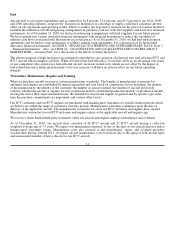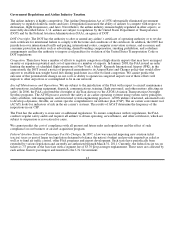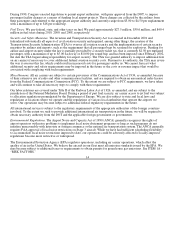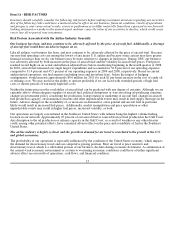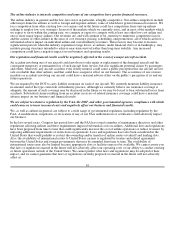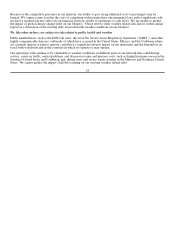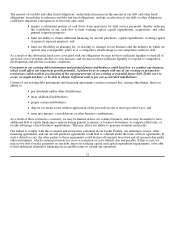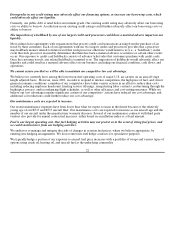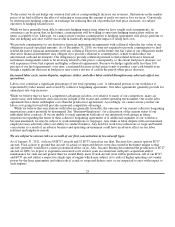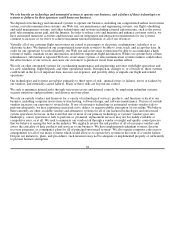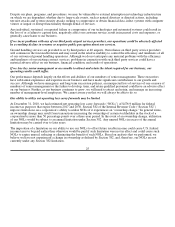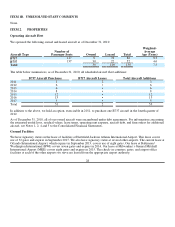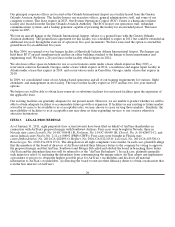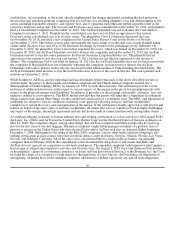Airtran 2010 Annual Report Download - page 28
Download and view the complete annual report
Please find page 28 of the 2010 Airtran annual report below. You can navigate through the pages in the report by either clicking on the pages listed below, or by using the keyword search tool below to find specific information within the annual report.
Like the U.S. and global equity and public debt markets, in recent years the market for lender or lessor financing has
undergone significant disruption, making it difficult for many businesses to obtain lender or lessor financing on acceptable
terms or at all. As a result of this disruption, we have experienced an increase in the costs associated with, and a decrease
in the availability of, borrowings necessary to operate our business. If economic conditions do not improve or again
worsen, our cost of borrowing may again further increase and it may be more difficult to obtain financing for our
operations or to refinance obligations as they come due in the ordinary course. If our available funding is withdrawn or
otherwise materially limited or we are forced to fund our operations at a higher cost, these conditions could require us to
curtail our business activities.
We have significant current and future obligations related to aircraft purchase commitments, indebtedness and lease
obligations. If we do not generate sufficient cash flows and / or are unable to access the capital markets, our liquidity
and our ability to fulfill such obligations could be impaired.
We have and will continue to have significant indebtedness and other commitments including aircraft purchase
commitments, significant debt and lease obligations related to existing purchased and leased aircraft, and debt and lease
obligations for existing and planned operating facilities.
Our aircraft purchase commitments for the next five years and thereafter, in aggregate, are (in millions): 2011•$50; 2012•
$270; 2013•$280; 2014•$370; and 2015•$520; and thereafter, $710. These amounts include payment commitments,
including payment of pre-delivery deposits and buyer-furnished equipment, for aircraft on firm order. Aircraft purchase
commitments include the forecasted impact of contractual price escalations. Our intention is to finance the aircraft on
order through either debt financing, lease financing, or a mix thereof. We have debt financing commitments from a lender
to finance a significant portion of the purchase price of two B737 aircraft scheduled for delivery to us in 2011 or 2012.
AirTran has no current arrangements for the financing of B737s other than as described in the immediately preceding
sentence. In addition, Boeing Capital Corporation (BCC), a wholly-owned subsidiary of the Boeing Company (Boeing),
has the right to require us to lease up to three additional used B717s for lease terms of up to 10 years per aircraft. If BCC
requires us to lease any such used B717 aircraft, we have the right to cancel a like number of B737 aircraft from our B737
order book with Boeing.
There are multiple variables including capital market conditions, asset valuations, and our own operating performance that
could affect the availability of satisfactory financing for our future B737 aircraft deliveries. While there was limited
availability of satisfactory aircraft financing in early 2009, it is our view that the aircraft financing market has improved.
While we cannot provide assurance that sufficient financing will be available, we expect to be able to obtain acceptable
financing for future deliveries. Our view is based upon our discussions with prospective lenders and lessors, the
consummation of aircraft financing transactions by other airlines, our own operating performance, and our recent ability
to refinance certain B737 aircraft.
Our B737 contract with Boeing requires us to make pre-delivery deposits to Boeing. Although we typically have financed
a significant portion of our pre-delivery deposit requirements with debt from banks or other financial institutions, we
currently have no such financing in place for future deliveries.
Our total indebtedness as of December 31, 2010, was $1.0 billion, of which $753.9 million was aircraft related. Of our
indebtedness, as of December 31, 2010, approximately $803.9 million, including amounts borrowed under our revolving
line of credit, was secured by certain of our assets, principally aircraft, which likely would limit the utility of such assets
in obtaining additional financing. Our ability to make scheduled payments of principal and interest for our obligations
depends on our future performance and financial results. These results are subject to general economic, financial,
competitive, legislative, regulatory and other factors that are, to some extent, beyond our control.
20



